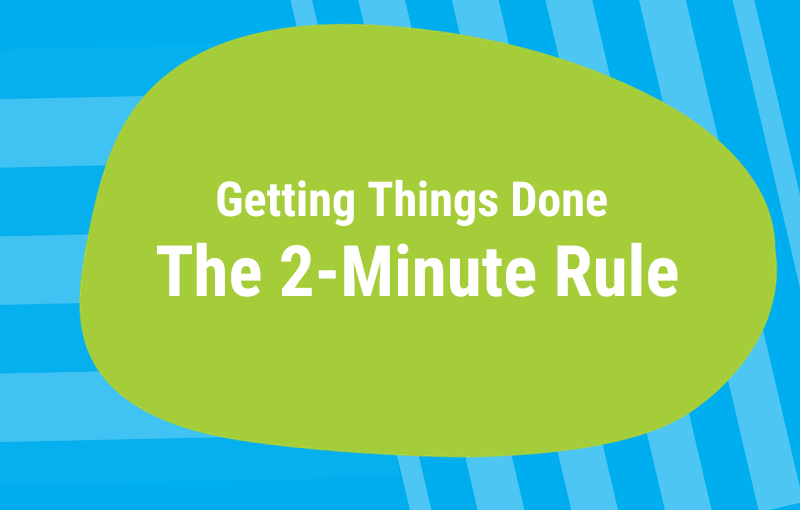The 2-minute rule has been around for a while.
I don’t know who ‘invented’ the 2-minute rule. Maybe it was David Allen who presented it in his book ‘Getting things done’, first published in 2001.
The 2-minute rule is still very popular and most productivity gurus have it in their toolbox.
I like it because it’s so simple and clear, it’s very effective, and it can be applied to things we need to do in all areas of our lives.
The 2-minute rule is a great tool that helps us overcome procrastinating and get small tasks done immediately, whenever they come up.
The 2-minute rule says,
‘If you can complete an action in less than two minutes, do it right away.’
This means that whenever a new to-do shows up, you ask yourself whether you can do it immediately. If the action is simple and won’t take very long, the best thing to do is to take care of it right away.
If left unsupervised, small tasks can become a nuisance.
If you don’t complete these simple and quick tasks right away, they can quickly build up a backlog on your to-do list.
Or, even worse, if you think these tasks are so small that it doesn’t make sense to write them down, they will take up precious space in your brain – and might distract you from working on your priority tasks.
The longer you put the small stuff off, the harder it feels to accomplish it.
Whether they end up on your physical or on your mental to-do list, uncompleted small tasks tend to pile up and can become a heavy mental burden and cause stress, guilt, or other negative feelings. Typically, the consequence is ongoing procrastination.
The solution to this dilemma is to intentionally create a new habit.
Whenever a new task arises, you ask yourself, ‘Can I do it now? Will it take less than 2 minutes?
If the answer is ‘no’, you put the task on your calendar or on your to-do list.
If it is ‘yes’, you complete the task immediately. And then you can forget about it.
Like any new habit, this one as well requires some practice and effort in the beginning. However, you will quickly get used to the rule because it is so easy to remember and realise.
Find suitable ways to remind yourself, again and again: ‘I do quick tasks quickly.’
You’ll soon begin to move through your day and work with more speed and efficiency. You will feel more active and productive. And you will automatically pay more attention to more quick to-dos – and get them all done automatically.
The 2-minute rule will turn into a 2-minute habit.
Yes, periods of procrastination might happen from time to time but they will become fewer. And it will be easier to overcome them – because you know you are no longer a procrastinator but a quick action taker.
Practice the 2-minute rule by getting the piled-up tasks sorted out.
The 2-minute rule is a productivity tool that we usually apply to newly incoming tasks. Whenever during the day a new task arises, we decide in that moment if we can do it quickly right now. If not, we transfer it to the calendar or to-do list.
However, if you have a huge backlog of uncompleted small tasks on your to-do list, you can decide to use whatever time you have available to reduce the amount of undone stuff. If you have 30 minutes, for example, before you need to leave the house, you can realistically tackle about 15 quick tasks.
Ideally, before you start to work on the backlog, you first group together tasks that must happen in the same context. For example, all quick stuff that must be done on the computer. Or all the little things that you want to get done in the kitchen.
The 2-minute rule can only work if you have 2 minutes time, of course.
It’s important to deliberately decide when you have the time to do 2-minute stuff and when you don’t have it.
If you are already late in the morning, for example, it doesn’t make sense to water the flowers even if that would take less than 2 minutes. You can’t do any 2-minute task righ now – because you need the 2 minutes to reach the bus.
However, if you are wainting for the doctor’s assistant to call you back, you can use one or two 2-minute periods to water the flowers and do other quick stuff.
Another thing to be careful about it the risk that we slip into doing numerous 2-minute tasks at a time when we actually should focus on finishing a bigger urgent project.
The rule is a tool to overcome procrastination and we don’t want to misuse it as an excuse to create additonal procrastination in our life.
The 2-minute rule can be applied in all areas of our life.
Some examples:
At work:
-
- The 2-minute rule can help you keep your inbox clear(er). You quickly evaluate each email: Can I get it done (read, delete, forward, answer, unsubscribe, …) right now? Will it take me less than 2 minutes? If the answer is yes, you know what to do.
- Let’s say you start a new project and decide you need a project folder – the right time to create the folder is now. (It takes less than 2 minutes.)
- You need to sign a document and get it back to your colleague? The best time to do it is now.
- You notice the paper basked it full – and you get up and empty it now.
- You decide that you won’t attend the business conference next week. And you call the travel agency to cancel the flight – right now
At home:
-
- In the morning, you switch on the coffee machine – and empty the dishwasher while you are waiting for the coffee to run through.
- After breakfast, you do the dishes – because it takes less than 2 minutes.
- Before you leave for work, it’s a quick thing to water the plants in the living room.
- In the evening, you clear up your home office desk. It’s a quick job.
- Coming home, you take in the mail and directly sort out what belongs in the paper basket.
- You open the mail – and immediately file a receipt for tax purposes.
- You stop on your way to the backyard and quickly transfer the laundry from the washing machine to the dryer.
- You arrange with your friends to meet for dinner on Friday and – directly after the call – make the online booking.
- You think of your mother’s birthday – and get up to wrap the present and write the card.
How to make use of the rule and create a 2-minute action habit
The first step could be to check what’s currently on your to-do list.
Are there any items that you could get rid of rather quickly by doing them quickly? If yes, set yourself a time frame and get them done, one after the other. And enjoy the feeling of being active and productive.
Another option: Imagine a typical day and how you move through it, from morning to evening, and create a list of typical 2-minute jobs.
What are some little tasks that often show up and could be done immediately that you usually don’t do immediately?
-
- Maybe, you leave the clothes from the day before on a chair in your bedroom and let them pile up until the end of the week. Would you have 2 minutes available in the morning to put them away?
- Do you usually quickly browse through your emails, just to see what’s there? What if you decided to invest 10 minutes to get about 5 emails sorted out immediately?
- Does it happen that you walk through the supermarket, wondering what you need to put in the trolley? What if you took 2 minutes in the morning to check the content of the fridge and write a shopping list?
- Do you often rush out of the office in the evening, leaving a mess on your desk? Could you decide to stop working 2 minutes before you leave and use them to clear up the desk?
Make a list of the typical daily quick tasks that you often postpone.
And then experiment with doing them just when they arise (or even before they arise).
HOW CAN I HELP YOU?
Are you tired?
Tired of trying to (re)organise the various areas of your life entirely on your own?
Fortunately, you don’t have to figure it out all by yourself.
We can do it together.
You can decide to get my support, advice, and guidance – and achieve the desired changes in your life so much faster and easier.

